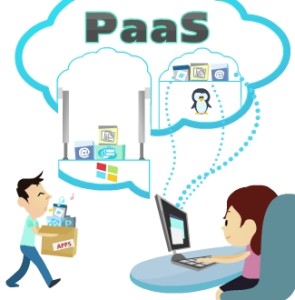 Cloud’s platform as a service market hasn’t even grown up yet, but already some people are saying it’s doomed.
Cloud’s platform as a service market hasn’t even grown up yet, but already some people are saying it’s doomed.
A report by 451 Research Group’s Senior Analyst Jay Lyman titled “Is PaaS becoming just a feature of IaaS?” codified a growing theory within the cloud computing industry that the PaaS market – which provides a cloud-based application development environment – will be consolidated into the two other major cloud models, infrastructure as a service (IaaS) and software as a service (SaaS).
Already IaaS and SaaS vendors have rolled out PaaS-like features for customers to build applications on their services. Leading SaaS company Salesforce.com, for example, has Force.com for users to build custom applications based on data already in the company’s cloud. IaaS providers like VMware, CenturyLink and Verizon have adopted PaaS technologies so customers can build applications and then host them in their IaaS cloud.
Meanwhile, there is a market of independent PaaS vendors taking a plethora of approaches to serve the needs of application developers. But, reports like Lyman’s cast a shadow of doubt over just what the future of this industry holds.
PaaS is an application development environment that sits in between IaaS and SaaS models. IaaS provides virtual compute, storage, database and other infrastructure hardware services on-demand, while SaaS gives customers cloud-based applications. PaaS allows developers to build applications that run in a cloud without having to worry about the underlying hardware that will be required to host it. A PaaS usually comes with tools to bake in features to the application, such as easy integration with security authentication services like Active Directory. Various PaaSs cater to applications written in different programming languages like .NET, Java or Ruby, while other PaaSs are polyglot, meaning they support multiple languages.
Because PaaSs are a way to build applications and the IaaS and SaaS layers host apps, there are natural confluences between these markets. IaaS and SaaS vendors are rolling out PaaS feature to become a one-stop shop for cloud services.
That could be good for end users, but Lyman says it could squeeze out pure-play PaaS vendors. “It is clear that PaaS is facing pressure and potentially being supplanted from below in the IT software stack by IaaS and from above by SaaS,” he writes in his report (This is a view that others in the industry, like North Bridge Venture Capital’s Michael Skok have expressed as well). “This is not to say PaaS as a set of capabilities and features or as a market will simply vanish, but it does highlight how the definition of PaaS is changing, particularly in the context of IaaS and SaaS,” Lyman’s report continues.
PaaS has played an important role in the cloud, and enthusiasts say that it could be a key model for enterprises to build custom applications in the future. Some of the biggest IaaS vendors in the market began their cloud go-to market strategies with PaaS before rolling out IaaS. Azure PaaS was the first Microsoft cloud service, while Google launched Google Application Engine (GAE) before Google Compute Engine (GCE), its IaaS.
But since then the PaaS market settled down as the IaaS and SaaS markets exploded. Amazon Web Services (AWS) has raced toward billions of dollars in annual revenue to lead the IaaS market and Salesforce.com drew more than 100,000 people to its SaaS-focused Dreamforce conference. PaaS vendors have been sitting somewhat in the shadows. Research firm Gartner estimates that of the $131 billion cloud computing market, PaaS represents about 1% of that, whereas SaaS sits at 14.7% of the market and IaaS at 5.5% (cloud-based business process services is the largest part of the market at 28%).
Perhaps the strongest indication of consolidation in the PaaS industry can be found in the merger, acquisition and partnership strategies of cloud vendors. Salesforce.com bought PaaS vendor Heroku for $249 million in 2010, CenturyLink bought pure-play public PaaS vendor AppFog in June of last year. IaaS vendors Rackspace, VMware and Verizon each added PaaS-like elements to their IaaS clouds in 2013. VMware uses the open source Cloud Foundry PaaS, which Verizon has latched onto as well. Rackspace started a new project within the OpenStack community named Solum to build PaaS services in OpenStack IaaS clouds. This absorption by IaaS vendors of PaaS features is a threat to pure-play PaaS vendors, Lyman says.
“A lot of people want to say PaaS is DOA – dead on arrival,” says Tim Crawford, a CIO strategic adviser at his independent firm AVOA. PaaS, as a standalone hosted platform, he agrees has a “challenging” road to enterprise adoption given moves by much bigger IaaS and SaaS vendors. What Crawford sees as a promising service is private PaaS, or an application development environment hosted by companies behind their own firewall for building new applications that can one day be hosted in a cloud. “Today, if I’m a CIO, I’m looking at how to make these new apps ‘cloudy,'” he says. “Private PaaS provides an opportunity for enterprises to start to move to the cloud, without taking on all of the risk of a hosted solution.” Vendors like Apprenda and CloudBees offer services in these areas.
PaaS enthusiasts say the talk of a PaaS demise is unwarranted. The industry is still young. “Any talk of PaaS being consumed into IaaS or SaaS is premature,” says Krishnan Subramanian, an industry watcher and a director of Red Hat’s strategy for its OpenShift PaaS project. “It is like writing an obituary about something before even seeing the value. If automation is cloud nirvana, PaaS offers the best automation with least complexity.” Customer adoption of PaaS products is just beginning. Give it time, he says.
The point for end users is that building applications for the cloud will be easier in the future, the question is just will it be done. Public IaaS cloud providers like Microsoft, Google, Rackspace, VMware and others will be rolling out application development features directly in their clouds. Another option is to go with an independent PaaS provider, but Lyman suggests those may eventually just get rolled into larger IaaS or SaaS vendors.





